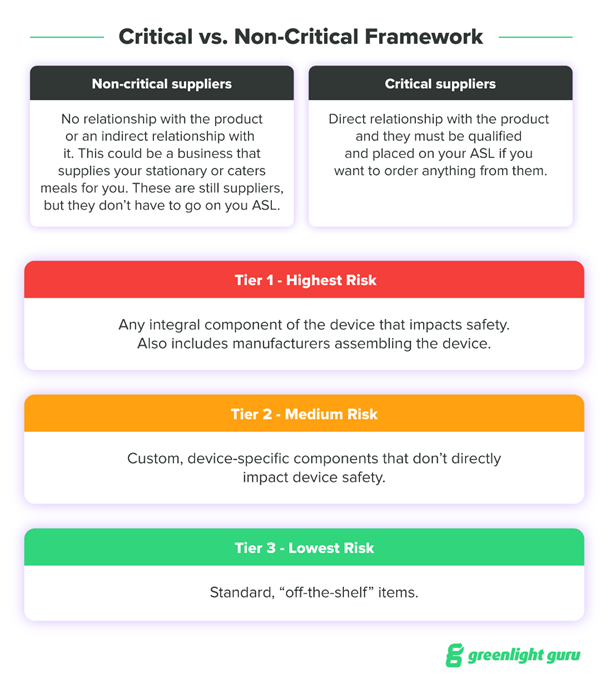Establishing A Medical Device Supplier Selection Process for Early and Mid-Stage Companies4/30/2024 When you need help in your device business how do you figure out where to go to find it? Just as important, how do you make sure the partner (supplier) you select is the right one for the job? Establishing a medical device supplier selection process (part of your Supplier Management system) is an important and vital process for any size company. Even though supplier management is mandated by quality management systems globally, its eye opening how many device companies don't have a formal process for identifying and selecting their supply chain partners. Making the wrong decision can lead to countless hours of wasted time and of course money down the drain. If the situation is grave enough, it could also cost someone their job. To find the right supplier, a ‘supplier selection' process is key to develop ahead of time. When considering implementing a formal supplier selection process for a medical device OEM some important steps to consider includes: 1. Consider the Regulations/ Standards: before you begin building out a supplier selection system make sure you get acquainted, or re-acquainted, with the quality requirements for your given global region. (USA & EU - ISO 13485:2016, section 7.4) While perhaps not the leading indicator as of 2024, additional insights can be gained by reviewing CFR 21 Part 820.50, subpart E. (purchasing controls) Chapter 7 of MDSAP can also provide insights in the event your company follows this regulation. 2. Simple Systems: if the idea is to systematize the process of selecting suppliers across a company, regardless of size, it's best to create a simple to follow procedure set as this will encourage adoption. 3. Internal Procedures: start by creating purchasing procedures which align appropriate decisions with justifiable needs. This is especially important if the supplier in question lands on the 'critical supplier' list. Outlining who internally can perform supplier qualifications, as well as who can approve suppliers. 4. Formulate Supplier Criteria: It’s important to know what you want, or most of what you want, before you begin looking for it. Utilizing a pre-established set of standardized criteria will help you ask the right questions, obtain the right information and compare capabilities across a multitude of supplier options. This also helps to remove information bias where we tend to make decisions based on emotional characteristics, rather than on sound science or facts. Depending on the supplier you’re looking for a Supplier Questionnaire can be useful in obtain this information, and or utilizing a Request for Proposal (RFP) process. Typical data you’ll want to obtain may include:
5. Experience and Expertise: Look for a partner(s) with experience in the area you need help with. The last thing you want is a company that will ‘figure it out’ or give it the old ‘college try’ while simultaneously billing you the for experience. Referrals and references are key here, especially if the supplier you’re considering falls in that elusive ‘critical few’ supply chain partner list. The best approach to finding the right supplier is by reaching out to others in your industry, or local industry associations, to learn who they use, and just as important who they don’t use. Take the time to read reviews, gather intel from people you trust before you start calling potential suppliers. While sites like Thomas.net and Google can provide this information it is likely you will quickly find yourself overwhelmed with information. In the end the most useful data is those that are unbiased or comes from experience which is best collected from trusted resources. 6. Proactively Learn About Your Suppliers Behaviors When speaking with a potential new supplier try connecting with the people you will be working with, not just the company’s salesperson. This is important because once the relationship is established most of your time won’t typically be spent with their salespeople rather those delivering the service or product. When courting a supplier pay attention to things like:
If they are a critical supplier it’s vital you learn about their business continuity plan. What if their manufacturing facility caught on fire? Shipping is seriously delayed. Or a key person leaves the company? Do they have plans in place in order to deal with serious situations which could impact their business, and yours? 7. Determine Risk: Every supplier you interact with must have a risk score associated to their involvement with your product and end user. Categorizing risk usually falls into two buckets: non-critical and critical. Greenlight Guru does a wonderful job articulating these categories and risk tiers in its article ‘Ultimate Guide to Supplier Management for Medical Device Companies’, as follows: 8. Perform Audits: while not every supplier needs to be formally audited, especially if you’re looking at a non-critical tier 3 supplier, in particular who is a service provider. That said, it can be a good rule of thumb to audit all suppliers to keep yourself, procedures and systems honest and consistent. It is recommended to audit any supplier which provides components, parts or raw materials, regardless of their risk level to ensure you are in compliance with standards such as ISO 13485. Audits can be done both onsite or offsite; critical suppliers require a much deeper dive into their capabilities and processes to ensure compliance and risk mitigation. Once an audit is performed its vital to finalize the process showing a clear determination of said supplier, including acceptance or rejection and the justification for the decision. 9. Selecting A Supplier: Before you make a final decision which supplier to go with take a step back and think big picture. Is there an opportunity now, or shortly down the road to be looking at economies of scale? Meaning – can one of your suppliers in question do more than just one thing? If so, selecting a supplier who can offer a multitude of capabilities may be the better partner – less points of contacts and companies in your supplier database, opportunity for better pricing if you’re giving them more of your business, increase efficiencies. There is a draw back to this idea which is important to be aware of which is it is wise not to have any one supplier dominating a particular part of your business as this gives them leverage. While single source suppliers aren’t uncommon, it’s advisable to slow the process down and really think through what you need today as well as in the next couple years to determine appropriateness of these kinds of relationships. 10. Agreements and Onboarding: There should never be a time where you go into business with a supplier and not sign a contract. Period. While there are a lot of things which are covered in a contract some of the key considerations may be product or service guarantees, indemnification, no-change clauses, audit openness, pricing and of course intellectual property agreements. Once contracts are signed its important to onboard the new supplier in a methodical and open arms approach. You have decided to go into business with this new supplier, treat them like gold. It may save you down the road. Schedule a formal meeting and invite all key stakeholders from both companies to the meeting. Key discussions for the onboard meeting should cover how the two companies will successfully work together, areas of opportunity in the next 6-12 months, points of contact, expectations on both sides, etc. While this step may seem a bit overkill, it’s important to you look a supplier relationship like they’re now part of the family. The way you treat them and the experience is inevitably what you’ll get as an outcome. 11. Requalifying Suppliers: When creating your supplier selection process it’s considered good measure to include a ‘requalifying process’ to ensure your company is managing its suppliers consistently and diligently. Using a standardized scorecard to capture performance data will make this process easier to manage and act on. A Closing Note on Cost Most supplier selection programs or processes don’t have a specified approach when dealing with the evaluation and costing of products, materials or services. That said, the bigger the company the more robust their approach and or data will be to work with specific to cost. Either way, reality often shows us it doesn’t matter how affordable or cost effective a supplier is, or how nice they are as people. If they can’t perform, and do so consistently, the other two ultimately don’t matter. In many situations I’ve found paying a bit more for the right product/ service and relationship often is worth the investment in the long run despite the extra cost up front. While cost is important, it’s usually not the driving factor when picking suppliers. For most supplier relationships it comes down to:
THE MEDTECH PROBLEM SOLVERS Square-1 Engineering, a medical device consulting firm, provides end to end technical project services to companies which design, develop and or manufacture life science products in Southern California. We utilize a unique approach in helping our customers complete their projects by combining the best of technical consulting services (hands on engineering & RAQA compliance) with technical training programs focused on building powerhouse teams.
0 Comments
Leave a Reply.About the AuthorTravis Smith is the founder and managing director of Square-1 Engineering, a medical device consulting firm, providing end to end engineering and compliance services. He successfully served the life sciences marketplace in SoCal for over 15 years and has been recognized as a ‘40 Under 40’ honoree by the Greater Irvine Chamber of Commerce as a top leader in Orange County, CA. Categories
All
Archives
July 2024
|
Visit Square-1's
|
|




 RSS Feed
RSS Feed


